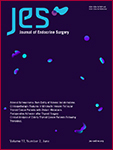The adrenal gland is a crucial endocrine organ, and adrenal tumors, mostly benign, often require surgical treatment. However, intraoperative localization of the adrenal gland is challenging due to its anatomical features. Laparoscopic surgery is widely used, but current laparoscopes lack real - time adrenal navigation. Near-infrared autofluorescence imaging (NIRAF) is a non-invasive technology that shows potential in adrenal localization, with limited reports globally and none in China. A 37-year-old female with a left adrenal nodule underwent retroperitoneoscopic left adrenal tumor resection. NIRAF technology, combined with laparoscopy, was used. The equipment had white light and near-infrared light modes. In the near-infrared light mode, the adrenal gland's autofluorescence was detected for intraoperative identification. Intraoperative NIRAF laparoscopy showed high-intensity fluorescence of the left adrenal tissue, clearly differentiating it from surrounding tissues. The surgery was completed within one hour without damage to surrounding organs. Post-operative monitoring of indicators such as blood pressure, aldosterone, adrenocorticotropic hormone, and white blood cell count was carried out. NIRAF technology has advantages in adrenal tumor resection, like improving surgical efficiency, reducing tissue manipulation, and lowering bleeding and infection risks. However, it has limitations such as weak light penetration and limited research. Further studies are needed to clarify its autofluorescence mechanism and evaluate its long-term effects.



